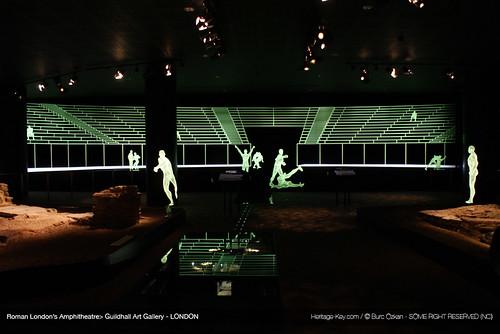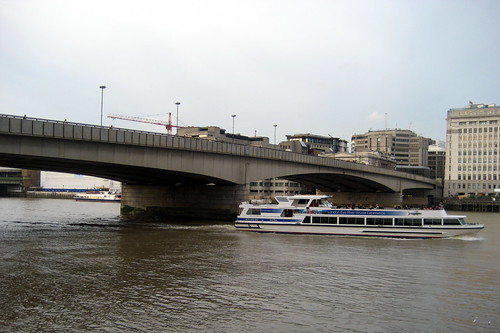Because of the densely-packed architectural layout of central London – site of Roman Londinium and Anglo-Saxon Lundenwic – most archaeological digs have had to take place opportunistically during building or other engineering works. They’ve turned up some fascinating finds – such as the evidence of the warpath of Queen Boudicca in 60 AD, found during work on the Jubilee Underground line, and the remains of the old Anglo-Saxon city, unearthed ahead of the redevelopment of the Royal Opera House in Covent Garden between 1996 and 1998.
We take a look ten of the most important ancient discoveries made in London to date. If you think there are any important finds that we’ve missed, as ever, leave us a comment at the bottom.
1. Roman Amphitheatre

The Roman Amphitheatre at the Museum of London
Year of discovery: 1985
Description: The remains of a Roman amphitheatre were uncovered beneath London’s medieval Guildhall during ambitious archaeological excavations carried out between 1985 and 1999. The structure – in use from the 1st to the 4th century AD – was the largest of its kind in Roman Britain.
2. Tomb of an Anglo-Saxon King
Location: Prittlewell, SouthendYear of discovery: 2004
Description: The array of extraordinary goods found in this Anglo-Saxon grave – including bronze cauldrons, gold foil crosses, glass jars, copper buckles, a sword and a shield – have led archaeologists to conclude that it must have been the final resting place of a very important individual, possibly even a king. Two possible Anglo-Saxon monarchs have been suggested – King Saebert, who converted to Christianity in 604 AD and died in 616 AD, or King Sigeberht II, who converted in 653 AD.

An archaeologist getting good and mucky in the dig for London's oldest wooden structure. Picture - Archaeology South-East.
3. London’s Earliest Timber Structure
Location: Greenwich, South East LondonYear of discovery: 2009
Description: A 6,000 year-old (that’s 500 years earlier than Stonehenge) wooden platform or trackway, found buried 4.7 metres deep in a peat bog adjacent to Belmarsh Prison. It would have used by prehistoric settlers to cross tricky boggy-patches when heading out into the Thames wetlands to hunt and gather food.
4. Anglo-Saxon London
Location: Royal Opera House, Covent GardenYear of discovery: 1996-1998
Description: Ahead of a major renovation works of the Royal Opera House, archaeologists were given a unique opportunity to investigate part of the area of old (6-9th century AD) Anglo-Saxon London – or Lundenwic. They discovered evidence of a far more substantial, well laid-out, and densely populated city than previously had been considered, with a grid system of roads, a money economy and a population of 10-12,000.
5. First Foundation of Roman London
Location: No 1. Poultry, City of LondonYear of discovery: 2000
Description: London’s most expensive archaeological dig – undertaken by the Museum of London Archeological Service (MOLAS) – took place during the construction of the controversial No 1. Poultry Building. It was worth every penny, since several significant discoveries – including a wooden drain along the main Roman road – were made. Dated to 47 AD using dendrochronology, it’s thought to give the date of the founding of Roman Londinium.
6. Boudicca’s Revenge Across the Thames
Location: Just south of London Bridge, Southwark
Year of discovery: 1995
Description: The extent of Queen of the Brittonic Iceni tribe Boudicca’s bloody revolt against the occupying Romans during in the 1st century AD was believed to have spread no further south than the Thames (see our video about Boudicca's bloody history here).
That was, until the discovery of a layer of burnt ash and timber along the route of a Roman road in Southwark (found during the tunneling of the Jubilee Underground line) dating from around 60 AD – the time of Boudicca’s rampage, which saw the slaughter of around 70 000 Romans and the burning of Londinium.7. Anglo-Saxon Cemetery
Location: Covent GardenYear of discovery: 2008
Description: The discovery of this Anglo-Saxon cemetery – in the area of Lundenwic (an area roughly approximate with the city's West End) – forced archaeologists to reassess the age of Anglo-Saxon London. Previously it was thought to have been founded in 650 AD, but radiocarbon dating of remains found in the graveyard forced that estimate back 100 years, to 550 AD. The quality of some artefacts discovered also suggested that the settlement was relatively wealthy and cosmopolitan from its first days.
8. Roman Cathedral
Location: Tower Hill, Tower HamletsYear of discovery: 1995
Description: Built out of masonry reused from other buildings in the late Roman period – between 350 AD and 400 AD – and burned down in the 5th century AD, this Roman cathedral must have been massive. Its remains suggest it was like a larger version of the church of St Thecla in Milan – the biggest church in the then-capital of the Roman Empire. It may have been erected by Magnus Maximus, western emperor between 383 AD and 388 AD.

The remains of a Roman bridge were found near London Bridge. Image credit - Wally Gobetz.
9. Roman Bridge
Location: Near London Bridge, City of LondonYear of discovery: 1981
Description: This massive pier base of a Roman bridge, discovered in the Thames, is believed to be the remains of the original London Bridge. It would have been made from wood, and proven vital to supplying important settlements further north – such as Colchester – from landing points in southern England. Around this crossing point, Londinium began to spring-up.
10. The King’s Highway
Location: Royal Opera House, Covent GardenYear of discovery: 1996-1998
Description: One of the key parts of Anglo-Saxon Lundenwic found during the excavation of the Royal Opera House was the so-called King’s Highway. This was a solid gravel road, a metre thick (far superior to its many side-roads) that would have been built and maintained at the public’s expense and function as the city’s main thoroughfare.